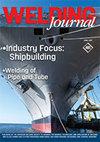不锈钢的凝固开裂敏感性:新的测试和解释
IF 1.4
3区 材料科学
Q2 METALLURGY & METALLURGICAL ENGINEERING
引用次数: 14
摘要
采用新的横向运动可焊性(TMW)试验评价了奥氏体、铁素体和双相不锈钢对凝固开裂的敏感性。重点是奥氏体不锈钢。304L和316L的易感程度最低,321的易感程度显著提高,310的易感程度更高。然而,一些321焊缝甚至比304L焊缝更不容易受到影响。发现这些321焊缝具有更细的晶粒,以更好地抵抗凝固开裂。在焊接过程中淬火321,发现非均相形核可以自发细化晶粒。对于304L、316L和310,基于柱状枝晶间液体的连续性,提出了磁化率的新解释;不连续的、孤立的液体可以使枝晶之间的结合尽早发生,从而更好地抵抗开裂。在304L和316L中,枝晶边界液体不连续且孤立。液体的耗尽可能是由于快速反扩散到以体为中心的状枝晶(体心立方)和L ++本文章由计算机程序翻译,如有差异,请以英文原文为准。
Solidification Cracking Susceptibility of Stainless Steels: New Test and Explanation
The susceptibility of austenitic, ferritic, and duplex stain-less steels to solidification cracking was evaluated by the new Transverse Motion Weldability (TMW) test. The focus was on austenitic stainless steels. 304L and 316L were least susceptible, 321 was significantly more susceptible, and 310 was much more susceptible. However, some 321 welds were even less susceptible than 304L welds. These 321 welds were found to have much finer grains to better resist solidification cracking. Quenching 321 during welding revealed spontaneous grain refining could occur by heterogeneous nucleation. For 304L, 316L, and 310, a new explanation for the susceptibility was proposed based on the continuity of the liquid between columnar dendrites; a discontinuous, isolated liquid allows bonding between dendrites to occur early to better resist cracking. In 304L and 316L, the dendrite-boundary liquid was discontinuous and isolated, as revealed by quenching. The liquid was likely depleted by both fast back diffusion into -dendrites (body-centered cubic) and the L + + reaction, which consumed L while forming . In 310, however, the dendrites were separated by a continuous liquid that prevented early bonding between them. Back diffusion into -dendrites (face-centered cubic) was much slower, and the L + + reaction formed little . Quenching also revealed skeletal/lacy formed in 304L and 316L well after solidification ended; thus, skeletal/lacy did not resist solidification cracking, as had been widely believed for decades. The TMW test further demonstrated that both more sulfur and slower welding can increase susceptibility.
求助全文
通过发布文献求助,成功后即可免费获取论文全文。
去求助
来源期刊

Welding Journal
工程技术-冶金工程
CiteScore
3.00
自引率
0.00%
发文量
23
审稿时长
3 months
期刊介绍:
The Welding Journal has been published continually since 1922 — an unmatched link to all issues and advancements concerning metal fabrication and construction.
Each month the Welding Journal delivers news of the welding and metal fabricating industry. Stay informed on the latest products, trends, technology and events via in-depth articles, full-color photos and illustrations, and timely, cost-saving advice. Also featured are articles and supplements on related activities, such as testing and inspection, maintenance and repair, design, training, personal safety, and brazing and soldering.
 求助内容:
求助内容: 应助结果提醒方式:
应助结果提醒方式:


